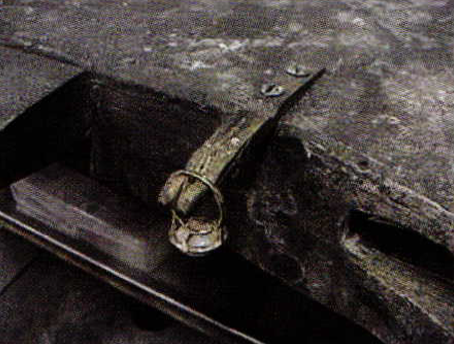Bench Mag Favorite Tips 2002 Part 4
3 Minute Read
This article page is from a section "Favorite Tips" from BENCH Magazine 2002 submitted by readers and BENCH Magazine Staff covering bench pins and shims, ring holder, setting melee and more,
~~~~~~~~~~~~~~~~~~~~~~~~~~~~~~~~~~~~
I've used spring clothespins in many configurations for a long, long time in my shop. What's great is that they're cheap, readily available, versatile and easily customizable. Here are some of my favorite uses.
Shank Cutting Bench Pin
Sometimes, using the standard bench pin is a bit awkward when cutting ring shanks. Simply remove the spring from a clothespin, align one half of the pin flat side down and extending over the front of your bench and screw it to your benchtop.
If you prefer to be able to swing it out of the way, use only one screw. Beginning at the front center of the pin, cut a straight groove all the way past the dip. The dip in the pin allows you to easily hold almost any ring for a straight cut.
Ring Holder
When masking a ring in preparation for rhodium finishing, it's sometimes difficult to find a way to hold the ring without getting nail polish all over your own fingers.
Simply clamp the ring shank into a clothespin and mask away. It will allow you a larger area to hold and keeps your fingers out ofthe way! You can also place the clothespin on the shelf with your plating solutions, and/or rectifier, keeping it out of the way until dry and ready to plate.
Bench Shim
When placing your bench in the appropriate area of your shop, you may find that the floor isn't quite level.
Rather than messing with trimming the legs or folding matchbooks, simply slide in half of a clothespin until the bench is steady. For a more 'finished'look, cut offthe remaining portion.
Organizers
When starting the day and organizing your work, group the similar jobs and clip them together with a clothespin marked for the type of task (size up, size down, polish, etc.) That way, you can find the task type with a quick glance. You can also use them to hold the job envelope(s) at the station you're currently working at, so as not to misplace them
- Joe Bacher
~~~~~~~~~~~~~~~~~~~~~~~~~~~~~~~~~~~~
Tip for channel setting multiple stones: As you snap stones into their seats, rub bee's wax over them. When all the stones are in the channel smear the wax across all the stones and scrape the top wax offso you can see that all the stones are at the angles you want. Hammer the whole channel at once, all the stones will stay put. Before steaming the wax out try to wiggle them with tweezers first to be sure one is not loose
- Jay Ritchie
~~~~~~~~~~~~~~~~~~~~~~~~~~~~~~~~~~~~
Tip for finding your chuck key: Make a brass wire twist around the chuck key and one just above the handpiece ofyour flexible shaft, both ending in a double ring (making a single hole); then loop 2 other pieces of wire together making them just long enough to reach from the end ofyour handpiece to the chuck hole. When the bit is changed it just drops out of the way. I use 4 pieces because over time I find fewer pieces tend to crimp and finally break.
- Jay Ritchie
~~~~~~~~~~~~~~~~~~~~~~~~~~~~~~~~~~~~
When setting several graduated melee in a ring, I use the same Sharpie markers I use for color-coding solder, to color code each size stone. It is much easier to distinguish a 1.5mm from a l.7mm when they are different colors, especially if they are "moved" when you are still laying them out. Simply dip the finished ring in alcohol and the color is gone.
- Theresa Murphy, CMBJ
~~~~~~~~~~~~~~~~~~~~~~~~~~~~~~~~~~~~
I have screwed a screw into the side of my bench pin. I use it to open jump rings when I attach them to a charm or a lobster claw or bracelet. It works like the rings they sell for you to wear with the screw attached, but you always know where this is.
- Theresa Murphy, CMBJ
~~~~~~~~~~~~~~~~~~~~~~~~~~~~~~~~~~~~
Suspend a small jelly or baby food jar in the comer of your ultrasonic cleaner. Use it as you would use a pickle-pot. You get both the heat and the ultrasonic action. It cleans fast. Use a similar setup in the other corner for your rhodium plating. The ultrasonic action helps get into spots that are missed with a dip into a normal beaker.
- Craig Bienfang
~~~~~~~~~~~~~~~~~~~~~~~~~~~~~~~~~~~~
Recycled Laundry Detergent Containers are great for bulk storage of many liquids. (Do not store acetone or other solvents that will corrode the plastic spout.)
- Steve Satow
~~~~~~~~~~~~~~~~~~~~~~~~~~~~~~~~~~~~
See Also:
You assume all responsibility and risk for the use of the safety resources available on or through this web page. The International Gem Society LLC does not assume any liability for the materials, information and opinions provided on, or available through, this web page. No advice or information provided by this website shall create any warranty. Reliance on such advice, information or the content of this web page is solely at your own risk, including without limitation any safety guidelines, resources or precautions, or any other information related to safety that may be available on or through this web page. The International Gem Society LLC disclaims any liability for injury, death or damages resulting from the use thereof.
The All-In-One Jewelry Making Solution At Your Fingertips
When you join the Ganoksin community, you get the tools you need to take your work to the next level.
Trusted Jewelry Making Information & Techniques
Sign up to receive the latest articles, techniques, and inspirations with our free newsletter.
